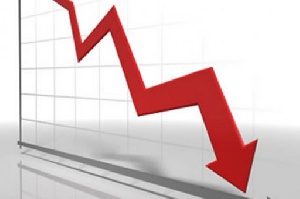Inflation for last month dropped to 11.6 percent, the lowest in over four years, after prices in non-food items such as transportation among others saw some significant downward movement.
October’s inflation was a 0.6 percentage points improvement on the 12.2 percent recorded in September – meaning general prices of goods and services have remained relatively stable within the period.
The last time inflation figures were this low was June 2013, when inflation recorded was 11.6 percent. The price index since then has seen erratic movement, reaching its highest point of 19.2 percent in March, 2016.
Acting Government Statistician, Baah Wadieh, attributed the drop to some non-food items; notably transportation and furnishings, among others.
“We attribute the fall in rate of inflation to the fall in rates for transportation, furnishings, household equipment and routine maintenance. In addition, there was a fall in inflation rate for alcoholic beverages, tobacco and narcotics groups, as well as miscellaneous goods and services.
“But these are all non-food items, so the fall results from a reduction in the rate of inflation for non-food groups,” he said.
Details of the release shows that the non-food items recorded a year-on-year inflation rate of 13.2 percent in October 2017, compared to the 14.1 percent recorded for September 2017. Five subgroups recorded year-on-year inflation rates higher than the group’s average rate of 13.2 percent.
Transport recorded the highest inflation rate of 18.5 percent, followed by clothing and footwear with 17.1 percent; recreation and culture with 16.8 percent; miscellaneous goods and services with 14.5 percent; and furnishings, household equipment and routine maintenance at 14.4 percent. Inflation was lowest in the Health subgroup, with 4.8 percent.
The food and non-alcoholic beverages group recorded a year-on-year inflation rate of 8.2 percent, a 0.1 percentage point higher than the rate recorded in September 2017.
One subgroup of the food and non-alcoholic beverages group recorded an inflation rate higher than the group’s average rate of 8.2 percent.
The rate for imported items was 12.2 percent compared with 13.5 percent recorded in September; and the inflation rate for locally-produced items was 11.4 percent, compared with 11.4 percent recorded in September.
This means that inflation rate for imported items in October 2017 was 0.8 percentage points higher than that of locally produced items.
At the regional level, the year-on-year inflation rate ranged from 9.1 percent in Upper East Region to 12.3 percent in the Greater Accra and Western Regions.
Five regions – Greater Accra, Western, Brong Ahafo, Ashanti and Eastern – recorded inflation rates above the national average, and Upper West and Central Regions recorded the same inflation rate as the national average – 11.6 percent.
Click to view details



Business News of Friday, 10 November 2017
Source: thebftonline.com
Inflation drops to 4-year low
Entertainment
















